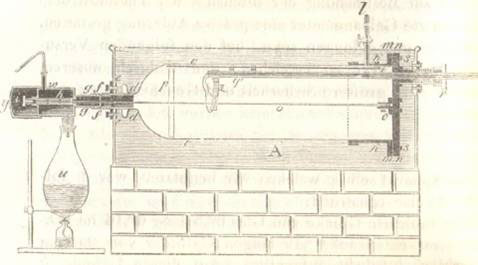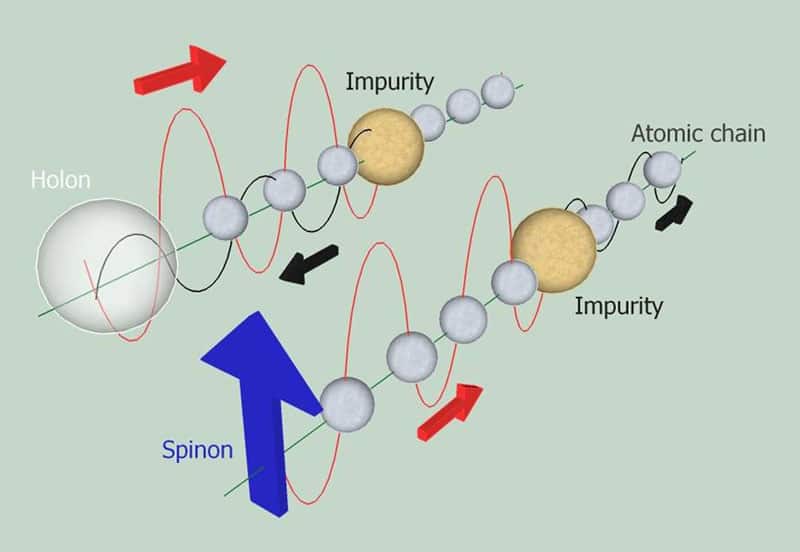
An international group of researchers has measured, for the first time, the phenomenon of spin–charge separation in bulk in a solid. They also found that the material violates the empirical Wiedemann–Franz law that has held true for more than 150 years.
The Wiedemann–Franz law says that the ratio of thermal to electrical conductivity for a metal is approximately the same for different metals at the same temperature. It has been known indirectly, for some time, that 1D metals – chains just one atom thick – are very different from metals in 2D or 3D.The researchers, led by Nigel Hussey at the University of Bristol, UK, were looking to test a prediction made by physicists Charles Kane and Matthew Fisher in 1996, which suggested a violation of the Wiedemann–Franz law if electrons are confined to individual atomic chains.
On the 1D scale, the electrons split into two distinct components or quasiparticles – a “spinon” that carries the spin but not charge and a “holon” that carries charge but not spin. This effect – known as spin–charge separation – is derived from the study of Fermi liquids and Tomonaga–Luttinger liquids. The electrons in a 3D metal can be described as a Fermi liquid which includes the effects of electrostatic – or Coulomb – interactions between the electrons, but where the effects of the interaction have a negligible effect. But confining the electrons to 1D “quantum wires” gives a Tomonaga–Luttinger liquid, in which Coulomb interactions are much more important. In this case, spin–charge separation occurs, causing the spin and charge to propagate in different directions with different velocities. One of the surprising but key results of Kane and Fisher’s prediction is that the ratio of thermal to electrical conductivity can be sensitive to this spin–charge separation.
Purple haze
Hussey explains that while the unusual behaviour of spin–charge separation is expected in a purely 1D substance, in a 3D complex solid there is always residual coupling between individual chains of atoms. This is one reason why, since the 1996 prediction, it is only now that an appropriate solid – the quasi-one-dimensional Li0.9Mo6O17, known as purple bronze – has been found. Within the bulk of the purple bronze, there are metallic conducting wires or atom chains running through an insulating matrix. The coupling within the atom chains is limited to such an extent that the electrons are effectively confined to individual chains – thus creating a 1D world inside the 3D complex.
The researchers measured the conductivity through the material by applying a current. “The chains are a few angstroms apart and many chains will have overlapping electronic orbitals. The coupling between chains and is weak, so electrons may only very occasionally hop across them.” explains Hussey.
The dramatic departure from the Wiedemann–Franz law occurs in purple bronze because when a holon comes across an impurity in the chain of atoms its motion is reflected – that is, it cannot navigate around or through the impurity. But the spinon can tunnel through the impurity and then continue along the chain. Because the spinons carry heat and the holons carry charge, the heat is conducted easily along the chain but charge is not. A similar effect occurs when the spinons or holons collide with each other. Both give rise to a violation of the Wiedemann–Franz law that grows with decreasing temperature. Interestingly, Hussey says that they were using the violation of the Wiedemann–Franz law in purple bronze “as a litmus test” to check the effective dimensionality of thier quasi 1D system. “We were surprised when the law was so spectacularly violated in this case.”
Dimensional Crossover
“There have been maybe a dozen reports of spin–charge separation before, but most of those are in completely 1D wires or nanowires or on the surface of bulk systems,” says Hussey. “This is arguably the first time it has been established deep inside the bulk of a 3D solid. But this crossover from an essentially 1D to a 3D state is not really understood and that is what we are looking at now.”
The researchers also found that when they placed the purple bronze in a magnetic field, it conducted heat as well as copper. “We were really surprised to see this as you would expect a 1D material to be a very poor conductor. But when placed in a magnetic field, the purple bronze conducted heat 100,000 times better than expected. We don’t really know why the heat is conducted so efficiently in a magnetic field and this is another aspect that we will be looking at,” says Hussey. He also points out that this surprising find could have potential technological applications.
Joel Moore, a physicist from the University of California, Berkeley in the US is impressed by the work. “There is growing application interest in various one-dimensional systems such as carbon nanotubes, and the results in this paper are confirmation that unusual 1D-specific effects appear even in ordinary transport phenomena. So I’d regard this as a model system that teaches us about other potentially useful systems.” he said.
Hussey and the team are now be investigating the high heat conduction effect in purple bronze, as well as looking at some organic conductors that are also bulk materials acting like 1D solids.
The research is published in Nature Communications.




